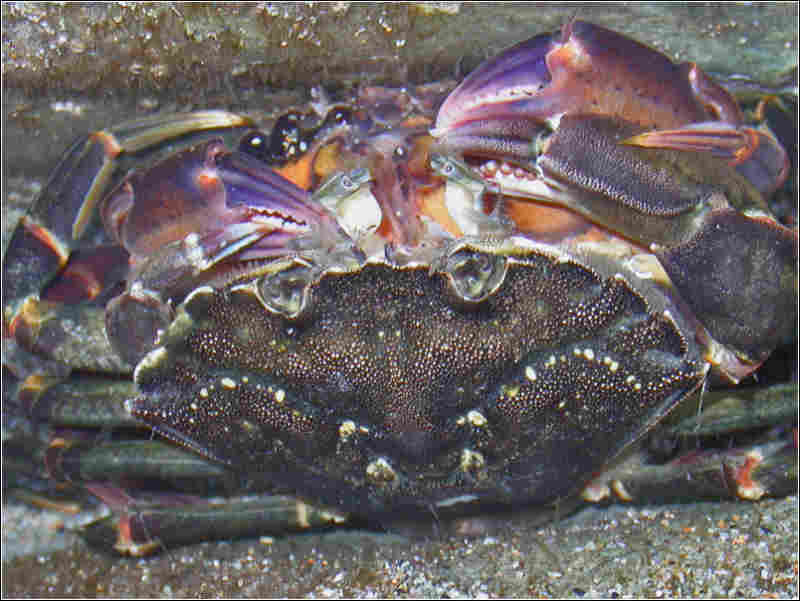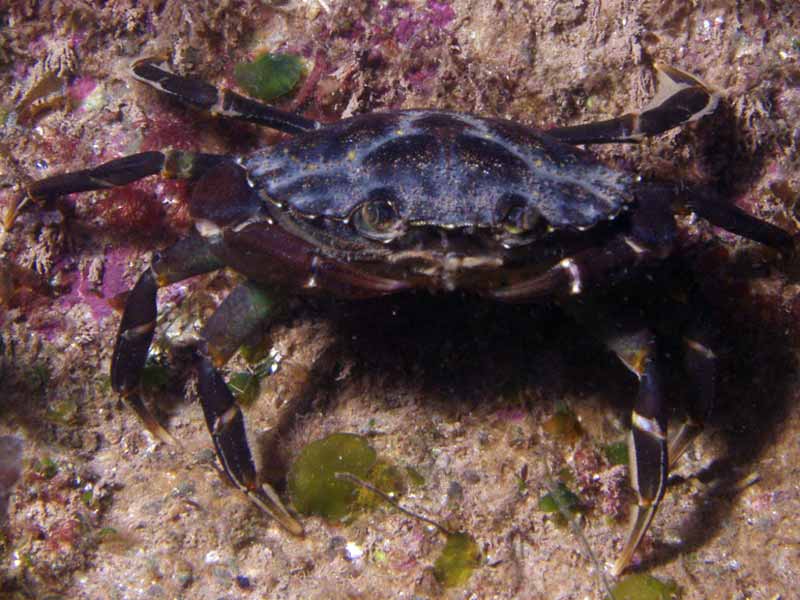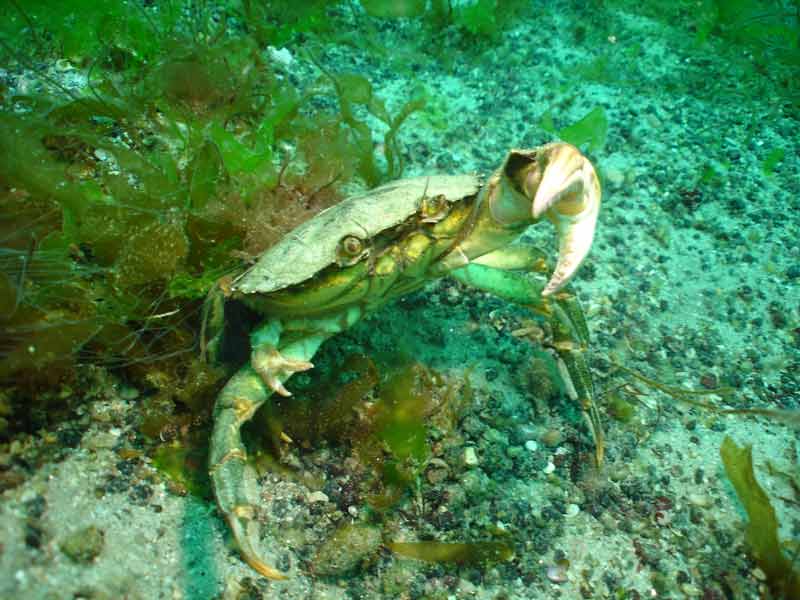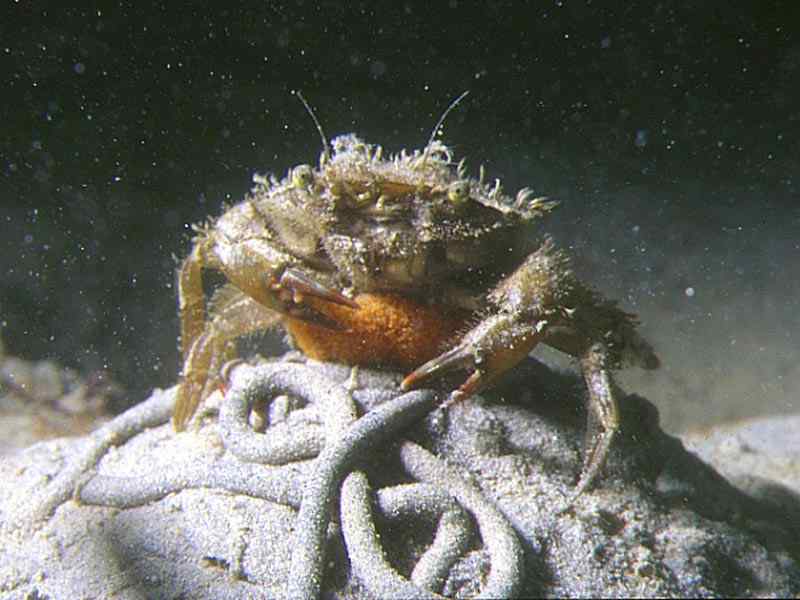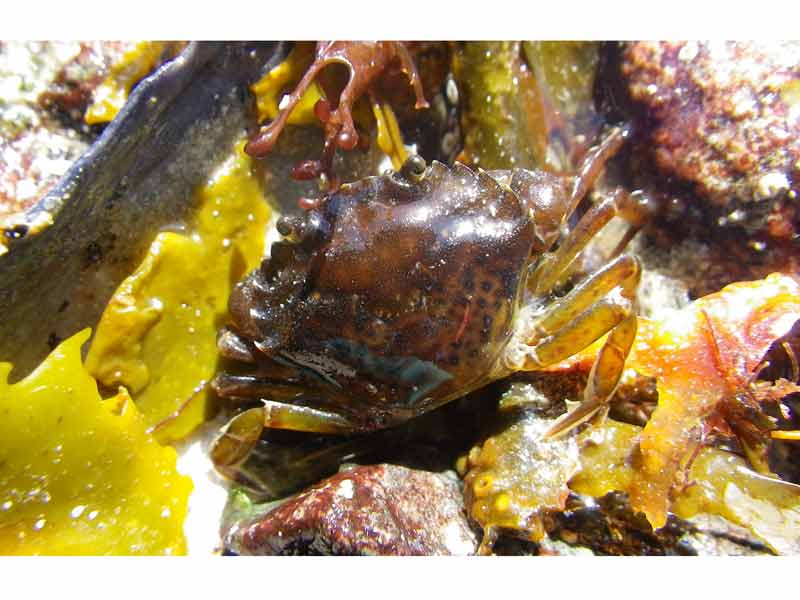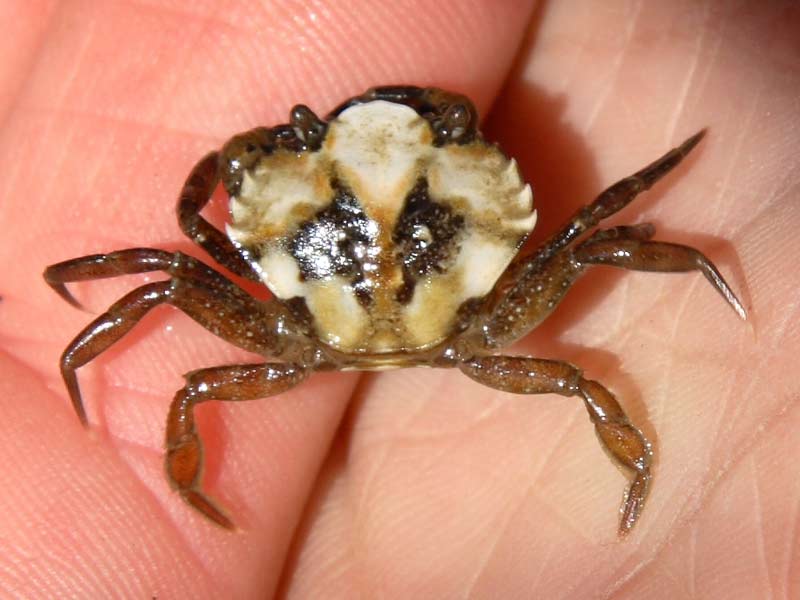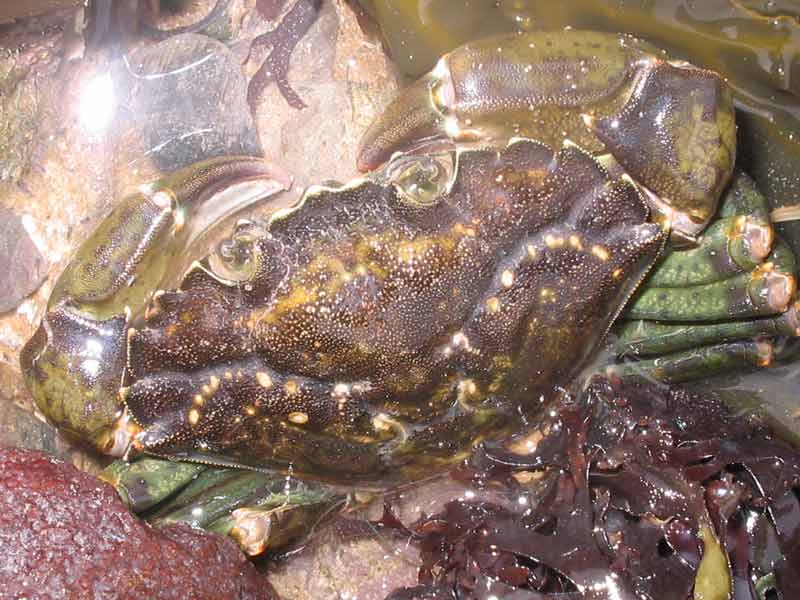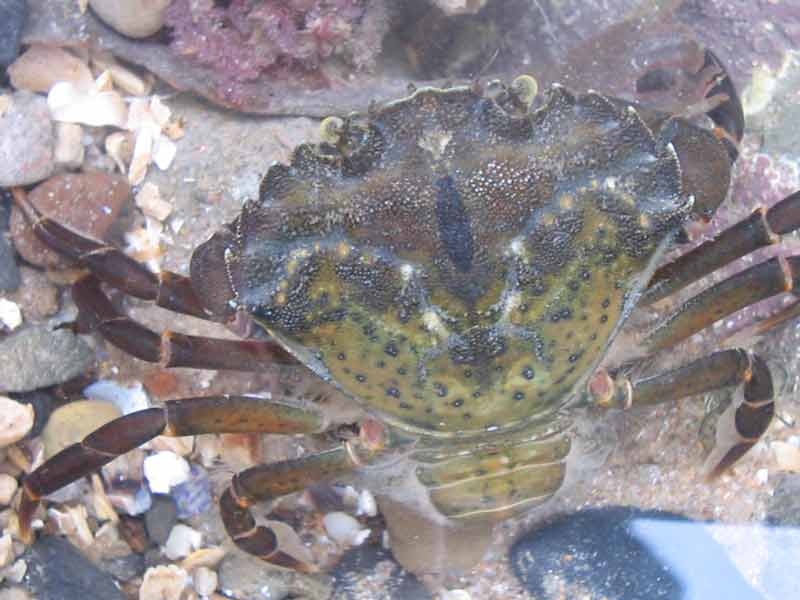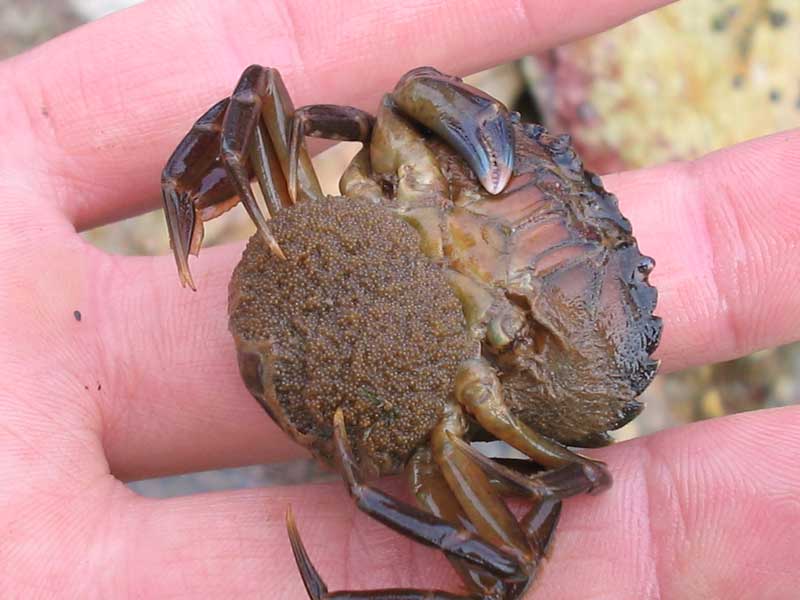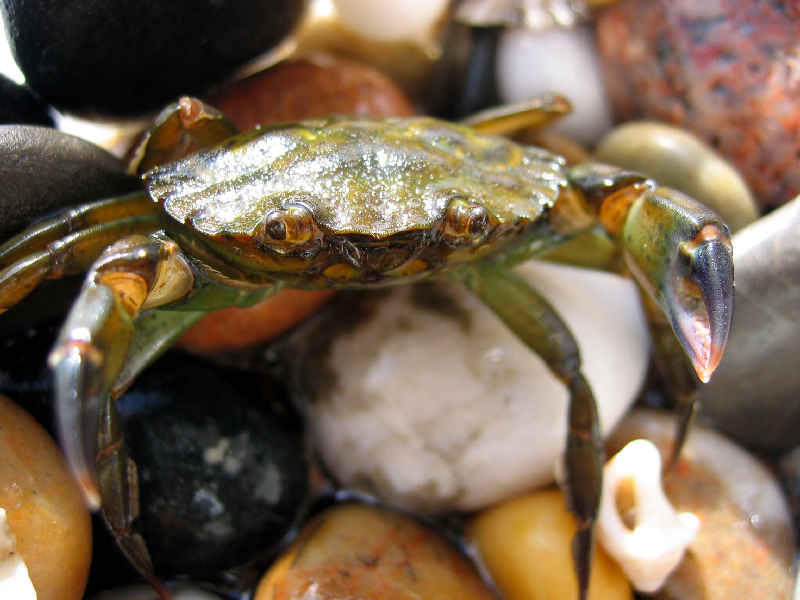Common shore crab (Carcinus maenas)
Distribution data supplied by the Ocean Biodiversity Information System (OBIS). To interrogate UK data visit the NBN Atlas.Map Help
| Researched by | Ken Neal & Paolo Pizzolla | Refereed by | This information is not refereed |
| Authority | (Linnaeus, 1758) | ||
| Other common names | - | Synonyms | - |
Summary
Description
The shore crab has a shell (carapace) that is much broader than long (up to 8 cm across). The front of the carapace is serrated with five teeth on either side and three rounded lobes between the eyes. The first pair of legs (pereopods) have well developed pincers (chelae). Its colour is highly variable from dark green to orange and red. Variation in colour may be due to the stage of the life cycle or the habitat. Juveniles in particular display a wide range of mottled patterns.
Recorded distribution in Britain and Ireland
This ubiquitous crab is found on all shores of Britain and Ireland.Global distribution
North Eastern Atlantic from northern Norway southwards to West Africa. It has been introduced to the USA, Sri Lanka, Red Sea, Madagascar, South Africa and Australia.Habitat
Carcinus maenas is found on all types of shore, from high water to depths of 60 m in the sublittoral, but it is predominantly a shore and shallow water species. It tolerates a wide range of salinities and is especially abundant in estuaries and salt marshes.Depth range
Intertidal down to 60 m.Identifying features
- Shell (carapace) up to 8 cm wide.
- Front of carapace serrated with five teeth either side of the eyes.
- Three rounded lobes between the eyes.
- Variable in colour from dark green to orange or red.
- Females can distinguished from males by examining the vestigal abdomen on the underside of the crab. Males have a triangular abdomen, while in females, the abdomen is rounded and of equal breadth for most of its length.
Additional information
No text entered
Listed by
- none -
Biology review
Taxonomy
| Level | Scientific name | Common name |
|---|---|---|
| Family | Carcinidae | |
| Genus | Carcinus | |
| Authority | (Linnaeus, 1758) | |
| Recent Synonyms | ||
Biology
| Parameter | Data | ||
|---|---|---|---|
| Typical abundance | High density | ||
| Male size range | 1-86 mm | ||
| Male size at maturity | 25-30 mm | ||
| Female size range | 15-31 mm | ||
| Female size at maturity | |||
| Growth form | Articulate | ||
| Growth rate | See additional information | ||
| Body flexibility | None (less than 10 degrees) | ||
| Mobility | Crawler or Walker | ||
| Characteristic feeding method | Predator, Scavenger | ||
| Diet/food source | Omnivore | ||
| Typically feeds on | Any animal or plant material (see additional information below). | ||
| Sociability | |||
| Environmental position | Epibenthic | ||
| Dependency | No information found. | ||
| Supports | No information | ||
| Is the species harmful? | No | ||
Biology information
Carcinus maenas is an easily identifiable crab of estuaries, sheltered rocky shores and offshore waters (Crothers, 1968). With increasing exposure on rocky shores, Carcinus maenas is replaced by other crab species such as the velvet swimming crab Necora puber, the bristly crab Pilumnus hirtellus, the edible crab Cancer pagurus and Montagu's crab Xantho incisus, and on increasingly exposed sandy areas by Pennant's swimming crab Portumnus latipes, the masked crab Corystes cassivelaunus, the harbour crab Polybius depurator and the flying crab, Polybius holsatus (Crothers, 1968). Some large Carcinus maenas have red limbs and undersides rather than the usual green. This is thought to be related to the breeding period (Ditmmann & Villbrandt, 1999) and prolonged intermoult, and is caused by photodegradation of the green exoskeletal pigment. Red morphs of Carcinus maenas were found to have a thicker carapace for greater protection during intraspecific conflict for mates. However, the red morph was also found to have a higher metabolic demand and were less tolerant to changes in salinity and temperature compared to the green morph (Dittmann & Villbrandt, 1999). Green Carcinus maenas are mainly found sheltering under algae where their colour blends in with the background. Red Carcinus maenas appear brown against a brown background in deep water and are mostly found in the shallow sublittoral where red light does not penetrate. Juvenile Carcinus maenas often have white patches on the carapace to break up their outline against shell and gravel (Crothers, 1968). In the Wadden Sea and, probably colder, northern parts of Britain, Carcinus maenas migrates to subtidal areas and remains there until spring. During this time the crabs are inactive in shelters and do not feed (Dittmann & Villbrandt, 1999). Lack of prey in the winter also leads to starvation and inactivity (Scott-Fordsmand & Depledge, 1993).
Growth. Carcinus maenas increases its body size by 20-33% per moult (Klein Breteler, 1975) and takes about 10 moults to reach 20 mm carapace width (CW) in its first year, if conditions are favourable (Crothers,1967). Carcinus maenas may moult more than once per year after the first year if conditions are good but the moulting rate slows once maturity is reached (Crothers, 1967) and is probably about once per year post maturity.
Diet. Carcinus maenas can be considered a true omnivore and consumes plants, algae, molluscs, arthropods (including their own species), annelids and carrion. Animal matter makes up the majority of the diet but some plant matter including algae and cord grass Spartina sp. is consumed. The diet of large Carcinus maenas mainly consists of molluscs and the common mussel Mytilus edulis is the most important of these. Smaller crabs (<30 mm CW) have more plant matter and arthropods in their diet. On rocky shores, juvenile Carcinus maenas were found to consume the barnacle Semibalanus balanoides whereas adults consume more gastropods (Rangley & Thomas, 1987) especially the dogwhelk Nucella lapillus and winkles Littorina sp. (Little & Kitching, 1996). Semibalanus balanoides is abundant and supports rapid growth (frequent moulting) in the early life stages of Carcinus maenas (Rangley & Thomas, 1987). Peak foraging occurs at night around high tide (Ropes, 1969). Predation rate is dependent on prey density (Walton et al., 2002) and temperature (Sanchez-Salazar et al., 1987).
Parasites. The most well-known parasite of Carcinus maenas is the rhizocephalan barnacle Sacculina carcini. This parasite infects by larval settlement on the exoskeleton and subsequent infection into the haemocoel by injection through a chitin 'needle' at the base of a hair on one of the legs of the host. Any larvae that do not settle adjacent to a hair base do not survive (Smith, 1907). Sacculina carcini castrates male and female Carcinus maenas and prevents moulting for the rest of the crabs life (Naylor, 2000; Thresher et al., 2000 and references therein). Infected crabs with sexually mature parasites carry a reproductive externae in the same way as females carry an egg mass when they are berried. The externae is distinguishable from an egg mass because it is smooth rather than granular (Naylor, 2000). Carcinus maenas is the 1st host of the acanthocephalan helminth Profilicollis botulus which infects eider ducks (Somateria mollissima) by ingestion of infected crabs. Juvenile eider ducks suffer some mortality from heavy infections and crabs are infected by eggs of the parasite from duck faeces(Thompson, 1985). Small Carcinus maenas (3-11 mm CW) can be attacked by the parasitoid platyhelminth Fecampia erythrocephala. This parasitoid is 8 to 12 mm long and replaces much of the digestive gland in the haemocoel. Infection is usually one worm per crab but may be as many as four. Once the worm is mature it exits the crab, killing it in the process. Prevalence in natural populations is about 7% and Kuris et al., (2002) suggested Fecampia erythrocephala may be a useful biocontrol where introduced Carcinus maenas are a pest because it kills crabs before they can mature and breed.
Predators. Common shore crabs are eaten mainly by fish and birds (e.g. gulls, cormorants, eider ducks) although it depends on the size of the crabs and on geographic location. For example, in some areas, predators of Carcinus maenas may include otters.
Habitat preferences
| Parameter | Data |
|---|---|
| Physiographic preferences | Open coast, Strait or Sound, Sea loch or Sea lough, Ria or Voe, Estuary, Isolated saline water (Lagoon), Enclosed coast or Embayment |
| Biological zone preferences | Lower circalittoral, Lower eulittoral, Lower infralittoral, Mid eulittoral, Sublittoral fringe, Upper circalittoral, Upper eulittoral, Upper infralittoral |
| Substratum / habitat preferences | No preference |
| Tidal strength preferences | Moderately strong 1 to 3 knots (0.5-1.5 m/sec.), Very weak (negligible), Weak < 1 knot (<0.5 m/sec.) |
| Wave exposure preferences | Extremely sheltered, Sheltered, Ultra sheltered, Very sheltered |
| Salinity preferences | Full (30-40 psu), Low (<18 psu), Reduced (18-30 psu), Variable (18-40 psu) |
| Depth range | Intertidal down to 60 m. |
| Other preferences | None found |
| Migration Pattern |
Habitat Information
No text enteredLife history
Adult characteristics
| Parameter | Data |
|---|---|
| Reproductive type | Gonochoristic (dioecious) |
| Reproductive frequency | Annual protracted |
| Fecundity (number of eggs) | 100,000-1,000,000 |
| Generation time | 1-2 years |
| Age at maturity | 1-2 years |
| Season | See additional information |
| Life span | 5-10 years |
Larval characteristics
| Parameter | Data |
|---|---|
| Larval/propagule type | - |
| Larval/juvenile development | Planktotrophic |
| Duration of larval stage | 1-2 months |
| Larval dispersal potential | Greater than 10 km |
| Larval settlement period | Insufficient information |
Life history information
Duration of reproductive season is related to geographical location. Egg-bearing females can be found year-round in the south of England, between January and April/May in the Bristol Channel and Wash area and only in spring in northern Scotland (Ingle, 1980). In areas where there is a defined reproductive season, females aggregate at 'hotspots' and males compete for copulatory opportunities (van der Meeren, 1994). Males preferentially select females with a carapace width 10 mm smaller than their own but are not size selective below this threshold and do not select females on the basis of imminence of moult (Reid et al., 1994). Males 65 mm carapace width or more are large enough to dominate competitive interactions and often mate with several females. However, males of this size only make up approximately 5% of the population (van der Meeren, 1994). Unmated males will try to displace males in precopula (a male carrying a female beneath its body held by one of the legs, prior to the female moulting) and always loses out to a male that has a carapace width 9 mm or larger than its own. Males that are similar size are likely to win intrasex conflicts 50% of the time (Reid et al., 1994).After moulting the 'soft' female is turned over by the male and copulation ensues through modified pleopods on the much reduced abdomen. As with most crabs, the female bears the fertilized eggs in a mass held between the abdomen and underside of the carapace. Females are berried for up to 4 months, depending on temperature, before the eggs hatch in spring/summer. Females in estuaries migrate to the mouth of the estuary to release larvae at night on ebb tides into fully saline water (Queiroga, 1996). At the southern limit of its range, larvae are released in winter when water temperatures are cooler (Sprung, 2001). Carcinus maenas was reported to breed only at temperatures below 18°C (Crothers, 1967). The maximum fecundity recorded was 185,000 eggs (Crothers, 1967).
Sensitivity review
The MarLIN sensitivity assessment approach used below has been superseded by the MarESA (Marine Evidence-based Sensitivity Assessment) approach (see menu). The MarLIN approach was used for assessments from 1999-2010. The MarESA approach reflects the recent conservation imperatives and terminology and is used for sensitivity assessments from 2014 onwards.
Physical pressures
Use / to open/close text displayed
| Intolerance | Recoverability | Sensitivity | Evidence / Confidence | |
Substratum loss [Show more]Substratum lossBenchmark. All of the substratum occupied by the species or biotope under consideration is removed. A single event is assumed for sensitivity assessment. Once the activity or event has stopped (or between regular events) suitable substratum remains or is deposited. Species or community recovery assumes that the substratum within the habitat preferences of the original species or community is present. Further details EvidenceCarcinus maenas displays very little preference for substratum, inhabiting everything from mudflats to bedrock. Therefore, it is unlikely to be affected by the loss of a particular substratum although its foraging success may be decreased and an intolerance of low has been recorded. | Low | High | Low | Low |
Smothering [Show more]SmotheringBenchmark. All of the population of a species or an area of a biotope is smothered by sediment to a depth of 5 cm above the substratum for one month. Impermeable materials, such as concrete, oil, or tar, are likely to have a greater effect. Further details. EvidenceCarcinus maenas is an extremely mobile organism and is capable of burrowing into sediment with its legs for shelter or when searching for prey such as the cockle Cerastoderma edule or the clam Mya arenaria. Therefore, it is unlikely to be significantly perturbed by a layer of sediment and tolerant has been recorded. Recruitment may be affected however, as mortality of post-settlement Carcinus maenas on sand flats is 80-90% (Moksnes et al., 1998). Therefore, if a large area of previously complex habitat was covered in sediment, post-settlement mortality would be much higher than before the deposition of the sediment. | Tolerant | Not relevant | Not sensitive | Low |
Increase in suspended sediment [Show more]Increase in suspended sedimentBenchmark. An arbitrary short-term, acute change in background suspended sediment concentration e.g., a change of 100 mg/l for one month. The resultant light attenuation effects are addressed under turbidity, and the effects of rapid settling out of suspended sediment are addressed under smothering. Further details EvidenceCarcinus maenas shows very little habitat preference and are found in clear rocky shore waters all the way through to turbid estuarine waters. Therefore, they are unlikely to be affected by an increase in suspended sediment. | Tolerant | Not relevant | Not sensitive | Low |
Decrease in suspended sediment [Show more]Decrease in suspended sedimentBenchmark. An arbitrary short-term, acute change in background suspended sediment concentration e.g., a change of 100 mg/l for one month. The resultant light attenuation effects are addressed under turbidity, and the effects of rapid settling out of suspended sediment are addressed under smothering. Further details EvidenceCarcinus maenas shows very little habitat preference and are found in clear rocky shore waters all the way through to turbid estuarine waters. Therefore, they are unlikely to be affected by a decrease in suspended sediment. | Tolerant | Not relevant | Not sensitive | Low |
Desiccation [Show more]Desiccation
EvidenceYoung crabs have been reported to survive for 10 days in moist air (Crothers, 1968) and can probably survive dry air for some time as well. Therefore, tolerant at the benchmark level has been recorded. | Tolerant | Not relevant | Not sensitive | High |
Increase in emergence regime [Show more]Increase in emergence regimeBenchmark. A one hour change in the time covered or not covered by the sea for a period of one year. Further details EvidenceThe activity rhythms of adult Carcinus maenas are entrained by salinity, hydrostatic pressure and temperature, and are therefore unaffected behaviourally by an increase in emergence. Juvenile crabs are entrained to some extent by periodicity of inundation and emergence (Reid et al., 1992), and may become active before immersion by the tide and become more vulnerable to predation by birds. Physiologically, Carcinus maenas is exceptionally tolerant (e.g. Ameyaw-Akumfi & Naylor, 1987; Crothers, 1968; Hill et al., 1991; Naylor, 2000) and will probably survive an extra hour of emergence until it can re-entrain to the new tidal cycle and migrate downshore to a suitable habitat. First and second instar Carcinus maenas live in the high intertidal and have finely tuned endogenous rhythms to ensure moulting occurs during inundation on spring tides (Zeng et al., 1999). A sudden increase in emergence coupled with these rhythms, which persist for 8 days in constant conditions (Zeng et al., 1999), could lead to moulting becoming dislocated from inundation on spring tides. However, mortality of Carcinus maenas due to an increase in emergence is unlikely and an intolerance of low has been recorded. | Low | Very high | Very Low | High |
Decrease in emergence regime [Show more]Decrease in emergence regimeBenchmark. A one hour change in the time covered or not covered by the sea for a period of one year. Further details EvidenceA decrease in emergence would allow Carcinus maenas to forage for longer and increase its food intake, especially on mussel or cockle beds. This would increase its growth rate and fecundity (Klein Breteler, 1975). Predation by fish, cephalopods and other crustaceans would probably increase but this would probably be tempered by reduced predation from birds, and tolerant has been recorded. | Tolerant* | Not relevant | Not sensitive* | Low |
Increase in water flow rate [Show more]Increase in water flow rateA change of two categories in water flow rate (view glossary) for 1 year, for example, from moderately strong (1-3 knots) to very weak (negligible). Further details EvidenceCarcinus maenas is replaced in high energy sand areas by Portumnus latipes, Corystes cassivelaunus, Polybius depurator andPolybius holsatus (Crothers, 1968), and so is likely to migrate away from an area where water flow rate increases. Mortality is likely to be low so a an intolerance of low has been recorded. | Low | Very high | Very Low | Moderate |
Decrease in water flow rate [Show more]Decrease in water flow rateA change of two categories in water flow rate (view glossary) for 1 year, for example, from moderately strong (1-3 knots) to very weak (negligible). Further details EvidenceCarcinus maenas can be found in salt marsh creeks and rockpools where water flow can be very low or non-existent and therefore a decrease in water flow is unlikely to affect Carcinus maenas and tolerant has been recorded. | Tolerant | Not relevant | Not sensitive | Low |
Increase in temperature [Show more]Increase in temperature
For intertidal species or communities, the range of temperatures includes the air temperature regime for that species or community. Further details EvidenceAt the benchmark level, Carcinus maenas is unlikely to be harmed by an increase in temperature as it can survive at least 23°C at the southern limit of its range in the Mediterranean Sea (Sprung, 2001). However, the adults will not breed over 18°C (Crothers, 1967) so summer breeding may be affected by a chronic increase. However, an increase in temperature also increases moulting rate (Klein Breteler, 1975), feeding rate (Sanchez-Salar et al., 1987) and salinity tolerance (Crothers, 1967) and therefore is likely to be of benefit to a population. Therefore, tolerant* has been recorded. | Tolerant* | Not relevant | Not sensitive* | High |
Decrease in temperature [Show more]Decrease in temperature
For intertidal species or communities, the range of temperatures includes the air temperature regime for that species or community. Further details EvidenceCarcinus maenas can tolerate a temperature range of at least 5 -26°C (Truchot, 1973) and therefore is unlikely to suffer mortality from a decrease in temperature at the benchmark level. Since increased temperature increases feeding rate (Sanchez-Salar et al., 1987) and moulting rate (Klein Breteler, 1975) it follows that a decrease in temperature would slow down feeding rate and growth rate. This is only a perturbation, however, and there would probably not be any mortality at the benchmark level and therefore tolerant has been recorded. However, in the severe winter of 1962-63, when water temperatures around the British coast fell to -1.5°C, large numbers of adult Carcinus maenas were caught in dredges and washed up upon the shore. Juveniles seemed to be unaffected (Crisp, 1964). | Tolerant | Not relevant | Not sensitive | High |
Increase in turbidity [Show more]Increase in turbidity
EvidenceCarcinus maenas is not reliant on clear water for any part of its adult life and so is unlikely to be affected by an increase in turbidity. One consequence may be increased productivity of filter-feeding prey items such as the mussel Mytilus edulis or the cockle Cerastoderma edule and therefore improved feeding for Carcinus maenas . | Not relevant | Not relevant | Not relevant | Low |
Decrease in turbidity [Show more]Decrease in turbidity
EvidenceCarcinus maenas is not reliant on clear water for any part of its adult life and so is unlikely to be affected by a decrease in turbidity. | Not relevant | Not relevant | Not relevant | Low |
Increase in wave exposure [Show more]Increase in wave exposureA change of two ranks on the wave exposure scale (view glossary) e.g., from Exposed to Extremely exposed for a period of one year. Further details EvidenceCarcinus maenas is typical of sheltered shores (Crothers, 1968) and estuaries (Ingle, 1997) and an increase in wave exposure may force Carcinus maenas out of areas where it is at the limit of its tolerance. An intolerance of intermediate has been recorded since some crabs are likely to be washed out of refuges by large waves and killed by further wave action or consumption by predators. | Intermediate | High | Low | Moderate |
Decrease in wave exposure [Show more]Decrease in wave exposureA change of two ranks on the wave exposure scale (view glossary) e.g., from Exposed to Extremely exposed for a period of one year. Further details EvidenceCarcinus maenas is typical of sheltered shores (Crothers, 1968) and estuaries (Ingle, 1997) and a decrease in wave exposure is likely to increase the available habitat for Carcinus maenas and tolerant* has been recorded. | Tolerant* | Not relevant | Not sensitive* | Moderate |
Noise [Show more]Noise
EvidenceCarcinus maenas is unlikely to be affected by noise at the benchmark level. | Tolerant | Not relevant | Not sensitive | High |
Visual presence [Show more]Visual presenceBenchmark. The continuous presence for one month of moving objects not naturally found in the marine environment (e.g., boats, machinery, and humans) within the visual envelope of the species or community under consideration. Further details EvidenceCarcinus maenas may adjust its behaviour in response to the presence of machinery or people, it will often adopt a defensive posture upon the approach of a person but mortality or emigration is unlikely and tolerant has been recorded. | Tolerant | Not relevant | Not sensitive | High |
Abrasion & physical disturbance [Show more]Abrasion & physical disturbanceBenchmark. Force equivalent to a standard scallop dredge landing on or being dragged across the organism. A single event is assumed for assessment. This factor includes mechanical interference, crushing, physical blows against, or rubbing and erosion of the organism or habitat of interest. Where trampling is relevant, the evidence and trampling intensity will be reported in the rationale. Further details. EvidenceDuring the construction of the "EUROPIPE" gas pipeline in the Wadden Sea, Carcinus maenas abundance was affected by construction activities across the route of tidal migration: crabs were most likely scared away and unable to migrate upshore than killed. The difference in Carcinus maenas abundance compared to pre-construction levels lasted only a few months (van Bernem, 1999). Physical disturbance will probably cause short term effects with rapid recovery due to the mobility and fecundity of Carcinus maenas. | Low | High | Low | Low |
Displacement [Show more]DisplacementBenchmark. Removal of the organism from the substratum and displacement from its original position onto a suitable substratum. A single event is assumed for assessment. Further details EvidenceTranslocated crabs quickly orient to concealment (Bliss, 1983) and are easily kept in captivity at high density. Therefore, they are tolerant of displacement as long as there is suitable refuge in the new area. | Tolerant | Not relevant | Not sensitive | High |
Chemical pressures
Use [show more] / [show less] to open/close text displayed
| Intolerance | Recoverability | Sensitivity | Evidence / Confidence | |
Synthetic compound contamination [Show more]Synthetic compound contaminationSensitivity is assessed against the available evidence for the effects of contaminants on the species (or closely related species at low confidence) or community of interest. For example:
The evidence used is stated in the rationale. Where the assessment can be based on a known activity then this is stated. The tolerance to contaminants of species of interest will be included in the rationale when available; together with relevant supporting material. Further details. EvidenceCypermethrin is an insecticide used to treat salmon for fish lice. At the concentration used on fish farms (5 µg/l) half the exposed Carcinus maenas died within 96 hours. However, most of the crabs displayed sublethal effects of stiffened limbs, outstretched chelae and unresponsiveness to visual or mechanical stimuli after 5 hours in cypermethrin treated water (Gowland, 2002). In the wild, this would make active crabs vulnerable to predation.
A solution of 200 ng/l of DDT (a concentration that may be found in the aquatic environment) inhibited Na K ATPase and Mg ATPase in the gills of Carcinus maenas and decreased the crabs' ability to osmoregulate. This effect was cumulative and increased with exposure time (Jowett et al., 1981) and would probably decrease the ability of Carcinus maenas to survive low salinity environments. Exposure to synthetic chemicals is likely to cause high mortality in Carcinus maenas populations and an intermediate intolerance has been recorded. | Intermediate | High | Low | High |
Heavy metal contamination [Show more]Heavy metal contaminationEvidenceCarcinus maenas is very tolerant of zinc pollution and was found to have loadings from 2087-3859 µg Zn per 10 g dry weight of crab; 60-80% of which was deposited in the exoskeleton (Chan & Rainbow, 1993) and was presumably lost at moulting. Even at very high concentrations, zinc does not cause significant mortality but it is not without metabolic effects. Carcinus maenas exposed to hypoxia (1.5 mg O2/l) and zinc pollution (0.25 mg/ l) switched to anaerobic respiration sooner than those exposed to hypoxia only (Johnson, 1987). In low salinity, in addition to zinc contamination and hypoxia, osmoregulation was interrupted by zinc but the experimental Carcinus maenas survived 96 hours in these conditions and then fully recovered in clean normoxic water (Johnson, 1988).
Overall, Carcinus maenas is very tolerant of metal contamination although mortality may occur at high concentrations of mercury. However, heavy metal contamination causes a wide range of metabolic effects and, therefore, an intolerance of low has been recorded. | Low | Very high | Very Low | High |
Hydrocarbon contamination [Show more]Hydrocarbon contaminationEvidenceCarcinus maenaspopulations were extinguished on some shores by oiling from the Torrey Canyon oil spill (Smith, 1968) and many were killed by effluent discharged into saltmarsh creeks from a Milford Haven refinery (Baker, 1976). | High | High | Moderate | High |
Radionuclide contamination [Show more]Radionuclide contaminationEvidenceCarcinus maenas accumulates antimony124 from its food (Weers & Louwrier, 1981) and uranium from water (Chassard-Bouchaud, 1983). Both are concentrated in the hepatopancreas and seem to cause little harm to Carcinus maenas even though concentrations of uranium can be 100 times higher in contaminated individuals compared to uncontaminated ones. Carcinus maenas is capable at least of detoxifying itself of uranium by moulting and voiding spherocrystals in which the uranium is bound (Chassard-Bouchaud, 1983). However, no evidence of adverse effects of radionuclides on Carcinus maenas was found and tolerant has been recorded. | Tolerant | Not relevant | No information | Moderate |
Changes in nutrient levels [Show more]Changes in nutrient levelsEvidenceCarcinus maenas is probably tolerant of nutrient input as it is tolerant of hypoxia that is often associated with organic enrichment. In addition, Carcinus maenas preys on species that can benefit from organic inputs, especially bivalve molluscs. Carcinus maenas normally excretes ammonium through the gills but in response to increased ammonium concentration, Carcinus maenas increases urea production and consequently has to increase gill permeability to take up more water for urine production. This in turn means that the affected Carcinus maenas has to increase energy expenditure on active ion transport, especially in low salinities (Spaargaren, 1990). Therefore, high energy demands may exclude Carcinus maenas from areas of organic enrichment in low salinity waters. The megalopae of Carcinus maenas select filamentous algae for settlement to avoid predation from cannibalistic juveniles (Moksnes et al., 1998; Moksnes, 2002). Eutrophication has been shown to cause algal mats to form on estuarine mudflats which may increase recruit survivorship. Therefore, tolerant has been recorded. | Tolerant | Not relevant | Not sensitive | Moderate |
Increase in salinity [Show more]Increase in salinity
EvidenceCarcinus maenas can tolerate salinities from 4-40 psu (Crothers, 1968; Ameyaw-Akumfi & Naylor, 1987) and has a preference for 27-40 psu, exhibiting halokinesis (non-directional movement in response to salinity) in a salinity gradient (Ameyaw-Akumfi & Naylor, 1987). Carcinus maenas is more tolerant of hypoxia (Legeay & Massabuau, 2000) and heavy metal accumulation (Bjerregard & Depledge, 1994) in higher salinities. Therefore, Carcinus maenas is likely to be tolerant of an increase in salinity at the benchmark level. | Tolerant | Not relevant | Not sensitive | High |
Decrease in salinity [Show more]Decrease in salinity
EvidenceCarcinus maenas remains in estuaries throughout each tidal cycle (as opposed to migrating in and out with the flood and ebb tides) and experiences from full salinity to almost freshwater twice daily (Ameyaw-Akumfi & Naylor, 1987). Therefore, it is very tolerant of a decrease in salinity. However, decreasing salinity decreases the tolerance of Carcinus maenas to hypoxia and heavy metal accumulation, presumably due to increased energetic demands. Because of the increased energetic demands in low salinity, berried females and parasitized Carcinus maenas avoid brackish water (Crothers, 1968). Overall, Carcinus maenas is probably tolerant of a decrease in salinity at the benchmark level. | Tolerant | Not relevant | Not sensitive | High |
Changes in oxygenation [Show more]Changes in oxygenationBenchmark. Exposure to a dissolved oxygen concentration of 2 mg/l for one week. Further details. EvidenceCarcinus maenas can survive up to 18 hours in complete anoxia by switching to anaerobic respiration and building up lactate. The crabs become inactive in anoxia and metabolic rate drops to <20% of that in normoxic conditions. Carcinus maenas is probably tolerant of hypoxia and is regularly subject to hypoxic conditions in rock pools, especially at night (Brante & Hughes, 2001). Exposure to 1.5 mg O2/l, about a quarter of normoxic oxygen levels, for 24 hours had little effect on metabolism (Johnson, 1987) and 1 mg O2/l increased the time taken to glean and consume the flesh of mussels but had no other effect (Brante & Hughes, 2001). Oxygen consumption doubles after feeding but Carcinus maenas can still survive long periods of hypoxia (Legeay & Massabuau, 2000). Hypoxia and low salinity in combination can cause some perturbation in Carcinus maenas. Exposure to 27 psu and 1.5 mg O2/l for 96 hours had no effect on crabs but when the salinity was reduced to 13 psu, osmoregulation was interrupted but none of the crabs died (Johnson, 1988). However, Carcinus maenas in salinities less than 10 psu in approximately 1.5 mg O2 l-1 switched to anaerobic respiration and there was 50% mortality within 24 hours (Legeay & Massabuau, 2000). The tolerance of Carcinus maenas to hypoxia does vary with season and is highest in the spring and summer during intermoult and lowest in winter just before the main moulting period (Legeay & Massabuau, 2000). Tolerant has been recorded because Carcinus maenas is unaffected by hypoxia (and even anoxia) in all but the most extreme conditions. | Tolerant | Not relevant | Not sensitive | High |
Biological pressures
Use [show more] / [show less] to open/close text displayed
| Intolerance | Recoverability | Sensitivity | Evidence / Confidence | |
Introduction of microbial pathogens/parasites [Show more]Introduction of microbial pathogens/parasitesBenchmark. Sensitivity can only be assessed relative to a known, named disease, likely to cause partial loss of a species population or community. Further details. EvidenceCarcinus maenas can contract bacterial haemolymph infections through wounds which cause death or prolong intermoult and are caused by a variety of bacteria including species of Vibrio, Bacillus and Aerococcus (Bliss, 1983). On very rare occasions, Carcinus maenas may become infected by Anophrys maggii, which consumes blood cells and causes death by anaemia and secondary bacterial infection (Bliss, 1983). Carcinus maenas is parasitized by Proficollis botulus, Fecampia erythrocephalus and Sacculina carcini (see adult general biology). Some mortality in Carcinus maenas populations is caused by microbial and parasitic infections and an intolerance of intermediate has been recorded. | Intermediate | High | Low | High |
Introduction of non-native species [Show more]Introduction of non-native speciesSensitivity assessed against the likely effect of the introduction of alien or non-native species in Britain or Ireland. Further details. EvidenceThe Chesapeake Bay Swimming Crab, Callinectes sapidus, was introduced to southeast England from America (Ingle, 1980; 1997). It has a similar diet to Carcinus maenas and the two species may compete for food (Ropes, 1989). | Low | Very high | Very Low | Low |
Extraction of this species [Show more]Extraction of this speciesBenchmark. Extraction removes 50% of the species or community from the area under consideration. Sensitivity will be assessed as 'intermediate'. The habitat remains intact or recovers rapidly. Any effects of the extraction process on the habitat itself are addressed under other factors, e.g. displacement, abrasion and physical disturbance, and substratum loss. Further details. EvidenceCarcinus maenas is sometimes sold at fish markets in France and Portugal and soft crabs (known as 'peelers') are used as fishing bait but although there is some mortality, neither are at a sufficient magnitude to significantly affect Carcinus maenas populations. | Intermediate | High | Low | Low |
Extraction of other species [Show more]Extraction of other speciesBenchmark. A species that is a required host or prey for the species under consideration (and assuming that no alternative host exists) or a keystone species in a biotope is removed. Any effects of the extraction process on the habitat itself are addressed under other factors, e.g. displacement, abrasion and physical disturbance, and substratum loss. Further details. EvidenceCarcinus maenas consumes such a wide range of food items that the extraction of one food type (e.g. mussels Mytilus edulis) would cause Carcinus maenas to switch to a different food type. Therefore, it is probably tolerant of extraction of its prey species. | Tolerant | Not relevant | Not sensitive | Not relevant |
Additional information
Recoverability. If a population of Carcinus maenas was completely wiped out by a catastrophic event, for example an oil spill, recovery is likely to be rapid as fecundity is high (up to 185,000 eggs) and reproduction is frequent (Crothers, 1968). The dispersal potential of larvae is high, and Carcinus maenas larvae have been found to colonize new areas at a rate of 1.9-8.7 km per year (Thresher et al., 2003 and references therein). Hence, the recolonization of defaunated areas is likely to be rapid. In addition, adults are very mobile and have been reported as travelling up to 15 km along a coast in 6 months (Thresher et al., 2003 and references therein). Carcinus maenas reaches maturity within 2 years (Crothers, 1967; Moksnes et al., 1998 and references therein) and a population of newly settled individuals are likely to grow rapidly and become self perpetuating within a few years.
Importance review
Policy/legislation
- no data -
Status
| National (GB) importance | - | Global red list (IUCN) category | - |
Non-native
| Parameter | Data |
|---|---|
| Native | - |
| Origin | - |
| Date Arrived | - |
Importance information
Carcinus maenas is a major predator of shellfish and is a pest in mariculture. In the UK, France and USA, metal mesh fences are used to protect mariculture of the blue mussel, Mytilus edulis, the oyster Ostrea edulis and the hard-shell clam Mercenaria mercenaria from predation by Carcinus maenas. Mytilus edulis does not reach a size refuge from Carcinus maenas predation until a shell length of 4 cm (approximate age of 1.5 years). Mussel 2-2.5 cm shell length seed stocks are surrounded by fences until they reach 4 cm shell length, when the fences are removed and the mussels continue to grow for another year until harvest size at 5.5 cm. Before fences were used, mortality of mussel seed stocks was 85% by harvest size. Fences reduced mortality to 15%. Carcinus maenas could completely destroy a 4m² area of seed mussels in 7 days, leaving only broken shells. Carcinus maenas is too abundant and mobile to be trapped to prevent mariculture damage (Davies et al., 1980).Carcinus maenas also causes significant damage to mariculture of the stepped clam Katelysia scalarina, in Australia (Walton et al., 2002) and has been blamed for much for the decline in sand gaper Mya arenaria landings in New England, USA (Ropes, 1969). Carcinus maenas also preys upon the common cockle Cerastoderma edule, preferring individuals <1.5 cm shell length and large male Carcinus maenas can consume up to 40 cockles daily in the summer months (Sanchez-Salar et al., 1987).
Bibliography
Ameyaw-Akumfi, C. & Naylor, E., 1987. Spontaneous and induced components of salinity preference behaviour in Carcinus maenas. Marine Ecology Progress Series, 37, 153-158.
Anderson, J.L. & Depledge, M.H., 1994. Arsenic accumulation in the shore crab Carcinus maenas: the influence of nutritional state, sex and exposure concentration. Marine Biology, 118, 285-292.
Baker, J.M., 1976. Investigation of refinery effluent effects through field surveys. In Marine Ecology and Oil Pollution (ed. J.M. Baker), pp. 201-225. Barking: Applied Science Publishers Ltd.
Bjerregaard, P. & Depledge, M.H., 1994. Cadmium accumulation in Littorina littorea, Mytilus edulis and Carcinus maenas: the influence of salinity and calcium ion concentrations. Marine Biology, 119, 385-395.
Brante, A. & Hughes, R.N., 2001. Effect of hypoxia on the prey-handling behaviour of Carcinus maenas feeding on Mytilus edulis. Marine Ecology Progress Series, 209, 301-305.
Chan, H.M. & Rainbow, P.S., 1993. The accumulation of dissolved zinc by the shore crab Carcinus maenas (L.). Ophelia, 38, 13-30.
Chassard-Bouchaud, C., 1983. Cellular and subcellular localization of uranium in the crab Carcinus maenas: a microanalytical study. Marine Pollution Bulletin, 14, 133-136.
Crisp, D.J. (ed.), 1964. The effects of the severe winter of 1962-63 on marine life in Britain. Journal of Animal Ecology, 33, 165-210.
Crothers, J.H., 1967. The biology of the shore crab Carcinus maenas (L.) 1. The background-anatomy, growth and life history. Field Studies, 2, 407-434.
Crothers, J.H., 1968. The biology of the shore crab Carcinus maenas (L.) 2. The life of the adult crab. Field Studies, 2, 579-614.
Davies, G., Dare, P.J. & Edwards, D.B., 1980. Fenced enclosures for the protection of seed mussels (Mytilus edulis L.) from predation by shroe crabs (Carcinus maenas L.). Fisheries Research Technical Report. MAFF, Lowestoft, 46, 14p.
Depledge, M.H., 1984a. Disruption of the endogenous rhthyms in Carcinus maenas (L.) following exposure to mercury pollution. Comparative Biochemistry and Physiology, 78A, 375-379.
Depledge, M.H., 1984b. Changes in cardiac activity, oxygen uptake and perfusion indices in Carcinus maenas (L.) exposed to crude oil and dispersant. Comparative Biochemistry and Physiology, 78C, 461-466.
Dittmann, S. & Villbrandt, M., 1999. Size frequency, distribution and colour variation of Carcinus maenas in Spiekeroog Backbarrier System. In The Wadden Sea ecosystem, (ed. S. Dittmann), pp.163-173. Germany: Springer-Verlag.
Fish, J.D. & Fish, S., 1996. A student's guide to the seashore. Cambridge: Cambridge University Press.
Gowland, B., 2002. Responses on the shore crab, Carcinus maenas (Decapoda, Brachyura), to an acute dose of cypermethrin. Crustaceana, 75, 89-93.
Hansen, J.I., Mustafa, T. & Depledge, M., 1992. Mechanisms of copper toxicity in the shore crab, Carcinus maenas. I. Effects on Na,K-ATPase activity, hemolymph electrolyte concentrations and tissue water contents. Marine Biology, 114, 253-257.
Hayward, P., Nelson-Smith, T. & Shields, C. 1996. Collins pocket guide. Sea shore of Britain and northern Europe. London: HarperCollins.
Hayward, P.J. & Ryland, J.S. (ed.) 1995b. Handbook of the marine fauna of North-West Europe. Oxford: Oxford University Press.
Hill, A.D., Taylor, A.C. & Strang, R.H.C., 1991. Physiological and metabolic responses of the shore crab Carcinus maenas (L.) during environmental anoxia and subsequent recovery. Journal of Experimental Marine Biology and Ecology, 150, 31-50.
Howson, C.M. & Picton, B.E., 1997. The species directory of the marine fauna and flora of the British Isles and surrounding seas. Belfast: Ulster Museum. [Ulster Museum publication, no. 276.]
Ingle, R., 1997. Crayfishes, lobsters and crabs of Europe. An illustrated guide to common and traded species. London: Chapman and Hall.
Ingle, R.W., 1980. British Crabs. Oxford: British Museum (Natural History), Oxford University Press.
JNCC (Joint Nature Conservation Committee), 1999. Marine Environment Resource Mapping And Information Database (MERMAID): Marine Nature Conservation Review Survey Database. [on-line] http://www.jncc.gov.uk/mermaid
Johnson, I., 1987. The effects of combinations of heavy metals, hypoxia and salinity on oxygen consumption and carbohydrate metabolism in Crangon crangon (L.) and Carcinus maenas (L.). Ophelia, 27, 155-169.
Johnson, I., 1988. The effects of combinations of heavy metals, hypoxia and salinity on ion regulation in Crangon crangon (L.) and Carcinus maenas (L.). Comparative Biochemistry and Physiology, 91C, 459-463.
Jowett, P.E., Rhead, M.M. & Bayne, B.L., 1981. In vivo changes in the activity of gill ATPases and haemolymph ions of Carcinus maenas exposed to p,p' -DDT and reduced salinities. Comparative Biochemistry and Physiology, 69C, 399-402.
Klein Breteler, W.C.M., 1975. Laboratory experiments on the influence of environmental factors on the frequency of moulting and the increase in size at the moulting of juvenile shore crabs, Carcinus maenas. Netherlands Journal of Sea Research, 9, 100-120.
Kuris, A.M., Torchin, M.E. & Lafferty, K.D., 2002. Fecampia erythrocephala rediscovered: prevalence and distribution of a parasitoid of the European shore crab, Carcinus maenas. Journal of the Marine Biological Association of the United Kingdom, 82, 955-960.
Legeay, A. & Massabuau, J.-C., 2000. Effect of salinity on hypoxia tolerance of resting green crabs, Carcinus maenas, after feeding. Marine Biology, 136, 387-396.
Little, C. & Kitching, J.A., 1996. The Biology of Rocky Shores. Oxford: Oxford University Press.
Moksnes, P. - O., Pihl, L. & van Montfrans, J., 1998. Predation on postlarvae and juveniles of the shore crab Carcinus maenas: importance of shelter, size and cannibalism. Marine Ecology Progress Series, 166, 211-225.
Moksnes, P.-O., 2002. The relative importance of habitat-specific settlement, predation and juvenile dispersal for distribution and abundance of juvenile shore crabs Carcinus maenas (L.). Journal of Experimental Marine Biology and Ecology, 271, 41-73.
Nagaraj, M., 1993. Combined effects of temperature and salinity on the zoeal development of the green crab, Carcinus maenas (Linnaeus, 1758) (Decapoda: Portunidae). Scientia Marina, 57, 1-8.
Naylor, P., 2000. Marine Animals of the South West. Plymouth: Sound Diving Publications
Nonnotte, L., Boitel, F. & Truchot, J.P., 1993. Waterborne copper causes gill damage and hemolymph hypoxia in the shore crab Carcinus maenas. Canadian Journal of Zoology, 71, 1569-1576.
Picton, B.E. & Costello, M.J., 1998. BioMar biotope viewer: a guide to marine habitats, fauna and flora of Britain and Ireland. [CD-ROM] Environmental Sciences Unit, Trinity College, Dublin.
Queiroga, H., 1996. Distribution and drift of the crab Carcinus maenas (L.) (Decapoda, Portunidae) larvae over the continental shelf off northern Portugal in April 1991. Journal of Plankton Research, 18, 1981-2000.
Reid, D.G., Abello, P. & Warman, C., 1992. Size and assortative mating in the shore crab Carcinus maenas. First European Crustacean Conference, Paris, August 31-September 5, 1992, Abstracts., MNHN, Paris (France), 124-125.
Reid, D.G., Abello, P., Warman, C.G. & Naylor, E., 1994. Size-related mating success in the shore crab Carcinus maenas (Crustacea: Brachyura). Journal of Zoology, 232, 397-407.
Ropes, J.W. 1989. The food habits of five crabs species at Pettaquamscutt River, Rhode Island. Fishery Bulletin, 87, 197-204.
Ropes, J.W., 1969. The feeding habits of the green crab, Carcinus maenas (L.). Fishery Bulletin of the U.S. Fish and Wildlife Service, 67, 183-203.
Scott-Fordsmand, J.J. & Depledge, M.H., 1993. The influence of starvation and copper exposure on the composition of the dorsal carapace and distribution of the trace metals in the shore crab Carcinus maenas (L.). Comparative Biochemistry and Physiology, 106C, 537-543.
Smith, G., 1907. The fixation of the cypris larva of Sacculina carcini (Thompson) upon its host, Carcinus maenas. Quarterly Journal of Microscopical Science, 51, 625-632.
Smith, J.E. (ed.), 1968. 'Torrey Canyon'. Pollution and marine life. Cambridge: Cambridge University Press.
Snachez-Salazar, M.E., Griffiths, C.L. & Seed, R., 1987. The effect of size and temperature on the predation of cockles Cerastoderma edule (L.) by the shore crab Carcinus maenas (L.). Journal of Experimental Marine Biology and Ecology, 111, 181-193.
Sprung, M., 2001. Larval abundance and recruitment of Carcinus maenas L. close to its southern geographical limit: a case of match and mismatch. Hydrobiologia, 449, 153-158.
Thresher, R., Proctor, C., Ruiz, G., Gurney, R., MacKinnon, C., Walton, W., Rodriguez, L. & Bax, N., 2003. Invasion dynamics of the European shore crab, Carcinus maenas, in Australia. Marine Biology, 142, 867-876.
Thresher, R.E., Werner, M., Høeg, J.T., Svane, I., Glenner, H., Murphy, N.E. & Wittwer, C., 2000. Developing the options for managing marine pests: specificity trials on the parasitic castrator, Sacculina carcini, against the European crab, Carcinus maenas, and related species. Journal of Experimental Marine Biology and Ecology, 254, 37-51.
Truchot, J.P., 1973. Temperature and acid-base regulation in the shore crab Carcinus maenas (L.). Respiration Physiology, 17, 11-20.
Van Bernem, K.H., 1999. Auswirkungen einer Pipeline-Verlegung auf das marine Benthos im Tidebecken von Baltrum-Langeoog. Aktuelle Probleme der Meeressumwelt. Vortraege des 9. Symposiums 26. Bis 27. Mai 1999 in Hamburg. No.10. 45-64. Deutsche Hydrographische Zeitschrift. Supplement.
van der Meeren, G.I, 1994. Sex- and size-dependent mating tactics in a natural population of shore crabs Carcinus maenas. Journal of Animal Ecology, 63, 307-314.
Van Weers, A.W. & Louwriers, P.W.F., 1981. Uptake and retention of 124Sb in the common mussel, shrimp and shore crab. In IAEA. Impacts of radionuclide releases into the marine environment. pp. 381-399. Vienna: IAEA. Vienna: IAEA.
Walton, W.C., MacKinnon, C., Rodriguez, L.F., Proctor, C. & Ruiz, G.M., 2002. Effect of an invasive crab upon a marine fishery: green crab, Carcinus maenas, predation upon a venerid clam, Katelysia scalarina, in Tasmania (Australia). Journal of Experimental Marine Biology and Ecology, 272, 171-189.
Wright, D.A., 1977. The effect of salinity on cadmium uptake by the tissues of the shore crab Carcinus maenas. Journal of Experimental Biology, 67, 137-146.
Zatta, P., Buso, P. & Moschini, G., 1985. Selenium distribution in the tissues of Carcinus maenas. Comparative Biochemistry and Physiology, 81C, 469-470.
Zeng, C., Abello, P. & Naylor, E., 1999. Endogenous tidal and semilunar moulting rhythms in early juvenile shore crabs Carcinus maenas: implications for adaptation to a high intertidal habitat. Marine Ecology Progress Series, 191, 257-266.
Datasets
Bristol Regional Environmental Records Centre, 2017. BRERC species records recorded over 15 years ago. Occurrence dataset: https://doi.org/10.15468/h1ln5p accessed via GBIF.org on 2018-09-25.
Bristol Regional Environmental Records Centre, 2017. BRERC species records within last 15 years. Occurrence dataset: https://doi.org/10.15468/vntgox accessed via GBIF.org on 2018-09-25.
Centre for Environmental Data and Recording, 2018. IBIS Project Data. Occurrence dataset: https://www.nmni.com/CEDaR/CEDaR-Centre-for-Environmental-Data-and-Recording.aspx accessed via NBNAtlas.org on 2018-09-25.
Centre for Environmental Data and Recording, 2018. Ulster Museum Marine Surveys of Northern Ireland Coastal Waters. Occurrence dataset https://www.nmni.com/CEDaR/CEDaR-Centre-for-Environmental-Data-and-Recording.aspx accessed via NBNAtlas.org on 2018-09-25.
Cofnod – North Wales Environmental Information Service, 2018. Miscellaneous records held on the Cofnod database. Occurrence dataset: https://doi.org/10.15468/hcgqsi accessed via GBIF.org on 2018-09-25.
Environmental Records Information Centre North East, 2018. ERIC NE Combined dataset to 2017. Occurrence dataset: http://www.ericnortheast.org.ukl accessed via NBNAtlas.org on 2018-09-38
Fenwick, 2018. Aphotomarine. Occurrence dataset http://www.aphotomarine.com/index.html Accessed via NBNAtlas.org on 2018-10-01
Fife Nature Records Centre, 2018. St Andrews BioBlitz 2014. Occurrence dataset: https://doi.org/10.15468/erweal accessed via GBIF.org on 2018-09-27.
Fife Nature Records Centre, 2018. St Andrews BioBlitz 2015. Occurrence dataset: https://doi.org/10.15468/xtrbvy accessed via GBIF.org on 2018-09-27.
Fife Nature Records Centre, 2018. St Andrews BioBlitz 2016. Occurrence dataset: https://doi.org/10.15468/146yiz accessed via GBIF.org on 2018-09-27.
Isle of Wight Local Records Centre, 2017. IOW Natural History & Archaeological Society Marine Invertebrate Records 1853- 2011. Occurrence dataset: https://doi.org/10.15468/d9amhg accessed via GBIF.org on 2018-09-27.
Kent Wildlife Trust, 2018. Biological survey of the intertidal chalk reefs between Folkestone Warren and Kingsdown, Kent 2009-2011. Occurrence dataset: https://www.kentwildlifetrust.org.uk/ accessed via NBNAtlas.org on 2018-10-01.
Kent Wildlife Trust, 2018. Kent Wildlife Trust Shoresearch Intertidal Survey 2004 onwards. Occurrence dataset: https://www.kentwildlifetrust.org.uk/ accessed via NBNAtlas.org on 2018-10-01.
Lancashire Environment Record Network, 2018. LERN Records. Occurrence dataset: https://doi.org/10.15468/esxc9a accessed via GBIF.org on 2018-10-01.
Manx Biological Recording Partnership, 2017. Isle of Man wildlife records from 01/01/2000 to 13/02/2017. Occurrence dataset: https://doi.org/10.15468/mopwow accessed via GBIF.org on 2018-10-01.
Manx Biological Recording Partnership, 2018. Isle of Man historical wildlife records 1990 to 1994. Occurrence dataset: https://doi.org/10.15468/aru16v accessed via GBIF.org on 2018-10-01.
Manx Biological Recording Partnership, 2018. Isle of Man historical wildlife records 1995 to 1999. Occurrence dataset: https://doi.org/10.15468/lo2tge accessed via GBIF.org on 2018-10-01.
Manx Biological Recording Partnership, 2022. Isle of Man historical wildlife records 1990 to 1994. Occurrence dataset:https://doi.org/10.15468/aru16v accessed via GBIF.org on 2024-09-27.
Merseyside BioBank., 2018. Merseyside BioBank (unverified). Occurrence dataset: https://doi.org/10.15468/iou2ld accessed via GBIF.org on 2018-10-01.
Merseyside BioBank., 2018. Merseyside BioBank Active Naturalists (unverified). Occurrence dataset: https://doi.org/10.15468/smzyqf accessed via GBIF.org on 2018-10-01.
National Trust, 2017. National Trust Species Records. Occurrence dataset: https://doi.org/10.15468/opc6g1 accessed via GBIF.org on 2018-10-01.
NBN (National Biodiversity Network) Atlas. Available from: https://www.nbnatlas.org.
Norfolk Biodiversity Information Service, 2017. NBIS Records to December 2016. Occurrence dataset: https://doi.org/10.15468/jca5lo accessed via GBIF.org on 2018-10-01.
OBIS (Ocean Biodiversity Information System), 2025. Global map of species distribution using gridded data. Available from: Ocean Biogeographic Information System. www.iobis.org. Accessed: 2025-08-05
Outer Hebrides Biological Recording, 2018. Invertebrates (except insects), Outer Hebrides. Occurrence dataset: https://doi.org/10.15468/hpavud accessed via GBIF.org on 2018-10-01.
South East Wales Biodiversity Records Centre, 2018. SEWBReC Myriapods, Isopods, and allied species (South East Wales). Occurrence dataset: https://doi.org/10.15468/rvxsqs accessed via GBIF.org on 2018-10-02.
South East Wales Biodiversity Records Centre, 2018. Dr Mary Gillham Archive Project. Occurance dataset: http://www.sewbrec.org.uk/ accessed via NBNAtlas.org on 2018-10-02
Suffolk Biodiversity Information Service., 2017. Suffolk Biodiversity Information Service (SBIS) Dataset. Occurrence dataset: https://doi.org/10.15468/ab4vwo accessed via GBIF.org on 2018-10-02.
The Wildlife Information Centre, 2018. TWIC Biodiversity Field Trip Data (1995-present). Occurrence dataset: https://doi.org/10.15468/ljc0ke accessed via GBIF.org on 2018-10-02.
Yorkshire Wildlife Trust, 2018. Yorkshire Wildlife Trust Shoresearch. Occurrence dataset: https://doi.org/10.15468/1nw3ch accessed via GBIF.org on 2018-10-02.
Citation
This review can be cited as:
Last Updated: 08/05/2008

